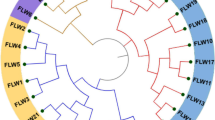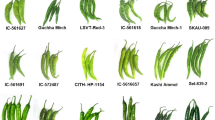Abstract
Selection of elite accessions is important to get the maximum quantity of bioactive compounds in medicinal plants. In this study, thirteen accessions of Plumbago zeylanica L., a medicinal herb, was studied for phytochemical and genetic diversity analysis. Phytochemical analysis showed that accession number IC-524441 contains the highest amount of flavonoids, phenolic, tannin and plumbagin content, it also possesses maximum antioxidant activity. Genetic diversity analysis showed that 15 SCoT (Start codon targeted) and 20 CBDP (CAAT Box Derived Polymorphism) primers produced 86 and 110 amplicons in total and average were 5.73 and 5.5 amplicons/primer respectively. PIC values ranged from 0.12 to 0.37 and average is 0.25/primer in the case of SCoT marker whereas, in the case of CBDP marker it was 0.15 to 0.59 with average of 0.26/primer. Cluster analysis showed that SCoT marker provides three clusters where cluster 1 and cluster 2 have only 2 accessions while cluster 3 contains nine accessions. Similarly, CBDP marker provides three clusters where cluster 1 contains only 1 accession and cluster 2 and cluster 3 contains six accessions in each. Further AMOVA analysis of SCoT marker possesses maximum variation of 8% among agro-ecological regions whereas in case of CBDP marker its 5%. From the present investigation, it was found that IC-524441 is an elite accession and contains highest amount of bioactive compound. Our results also demonstrate that both SCoT and CBDP markers are informative and can be utilized for evaluation of genetic relationships among Plumbago zeylanica L. accessions.


Similar content being viewed by others
References
Abdin MZ, Arya L, Verma M (2017) Use of SCoT markers to assess the gene flow and population structure among two different populations of bottle gourd. Plant Gene 9:80–86
Agarwal A, Gupta V, Haq SU, Jatav PK, Kothari SL, Kachhwaha S (2019) Assessment of genetic diversity in 29 rose germplasms using SCoT marker. J King Saud Univ Sci 31(4):780–788
Cory H, Passarelli S, Szeto J, Tamez M, Mattei J (2018) The role of polyphenols in human health and food systems: a mini-review. Front Nutr 5:87
Etminan A, Pour-Aboughadareh A, Mehrabi AA, Shooshtari L, Ahmadi-Rad A, Moradkhani H (2019) Molecular characterization of the wild relatives of wheat using CAAT-box derived polymorphism. Plant Biosyst Int J Dealing All Aspects Plant Biol 153(3):398–405
Gaafar ARZ, Al-Qurainy F, Khan S (2014) Assessment of genetic diversity in the endangered populations of Breonadia salicina (Rubiaceae) growing in The Kingdom of Saudi Arabia using inter-simple sequence repeat markers. BMC Genet 15(1):109
Gholamian F, Etminan A, Changizi M, Khaghani S, Gomarian M (2019) Assessment of genetic diversity in Triticum urartu Thumanjan ex Gandilyan accessions using start codon targeted polymorphism (SCoT) and CAAT-box derived polymorphism (CBDP) markers. Biotechnol Biotechnol Equip 33(1):1653–1662
Gorji AM, Poczai P, Polgar Z, Taller J (2011) Efficiency of arbitrarily amplified dominant markers (SCoT, ISSR and RAPD) for diagnostic fingerprinting in tetraploid potato. Am J Potato Res 88(3):226–237
Gupta V, Jatav PK, Haq SU, Verma KS, Kaul VK, Kothari SL, Kachhwaha S (2019) Translation initiation codon (ATG) or SCoT markers-based polymorphism study within and across various Capsicum accessions: insight from their amplification, cross-transferability and genetic diversity. J Genet 98(2):61
Haji RFA, Bhargava M, Akhoon BA, Kumar A, Brindavanam NB, Verma V (2014) Correlation and functional differentiation between different markers to study the genetic diversity analysis in medicinally important plant Plumbago zeylanica. Ind Crops Prod 55:75–82
Hajibarat Z, Saidi A, Hajibarat Z, Talebi R (2015) Characterization of genetic diversity in chickpea using SSR markers, start codon targeted polymorphism (SCoT) and conserved DNA-derived polymorphism (CDDP). Physiology and molecular biology of plants 21(3):365–373
Heikrujam M, Kumar J, Agrawal V (2015) Genetic diversity analysis among male and female Jojoba genotypes employing gene targeted molecular markers, start codon targeted (SCoT) polymorphism and CAAT box-derived polymorphism (CBDP) markers. Meta Gene 5:90–97
Jain P, Sharma HP, Singh P (2020) Anti-fungal, anti-oxidant and phytochemical analysis of Plumbago zeylanica L. Vegetos 1–11
Jayanthi M, Gokulanathan A, Haribalan P, Ashakiran K, Kumar CD, Kamla D, Renukadevi BS (2020) Plumbagin from two Plumbago species inhibits the growth of stomach and breast cancer cell lines. Ind Crops Prod 146:112147
Kumar J, Agrawal V (2019) Assessment of genetic diversity, population structure and sex identification in dioecious crop, Trichosanthes dioica employing ISSR. SCoT SRAP Markers Heliyon 5(3):e01346
Kumar S, Pandey AK (2013) Chemistry and biological activities of flavonoids: an overview. Sci World J 2013:162750
Kurutas EB (2015) The importance of antioxidants which play the role in cellular response against oxidative/nitrosative stress: current state. Nutr J 15(1):71
Nadeem MA, Nawaz MA, Shahid MQ, Doğan Y, Comertpay G, Yıldız M, Özkan H (2018) DNA molecular markers in plant breeding: current status and recent advancements in genomic selection and genome editing. Biotechnol Biotechnol Equip 32(2):261–285
Paliwal R, Singh R, Singh AK, Kumar S, Kumar A, Majumdar RS (2013) Molecular characterization of Giloe (Tinospora cordifolia Willd. Miers ex Hook. F. and Thoms.) accessions using start codon targeted (SCoT) markers. Int J Med Arom Plants 3(4):413–422
Panche AN, Diwan AD, Chandra SR (2016) Flavonoids: an overview. J Nutr Sci 5:e47
Panda S, Naik D, Kamble A (2015) Population structure and genetic diversity of the perennial medicinal shrub Plumbago. AoB Plants 7:plv048
Pizzi A (2019) Tannins: prospectives and actual industrial applications. Biomolecules 9(8):344
Roy A, Bharadvaja N (2017a) A review on pharmaceutically important medical plant: Plumbago zeylanica. J Ayurved Herbal Med 3(4):225–228
Roy A, Bharadvaja N (2017b) Silver nanoparticles synthesis from a pharmaceutically important medicinal plant Plumbago zeylanica. MOJ Bioequiv Availab 3(5):00046
Roy A, Bharadvaja N (2018) Effect of various culture conditions on shoot multiplication and GC–MS analysis of Plumbago zeylanica accessions for plumbagin production. Acta Physiol Plant 40(11):190
Roy A, Bharadvaja N (2019) Silver nanoparticle synthesis from Plumbago zeylanica and its dye degradation activity. Bioinspired, Biomimetic and Nanobiomaterials 8(2):130–140
Roy A, Bharadvaja N (2017) Establishment of the shoot and callus culture of an important medicinal plant Plumbago zeylanica. Adv Plants Agric Res 7(5):00274
Roy A, Bharadvaja N (2019) Establishment of root suspension culture of Plumbago zeylanica and enhanced production of plumbagin. Ind Crops Prod 137:419–427
Satya P, Karan M, Jana S, Mitra S, Sharma A, Karmakar PG, Ray DP (2015) Start codon targeted (SCoT) polymorphism reveals genetic diversity in wild and domesticated populations of ramie (Boehmeria nivea L. Gaudich.), a premium textile fiber producing species. Meta Gene 3:62–70
Saxena A, Gautam S, Arya KR, Singh RK (2016) Comparative study of phytochemicals, antioxidative potential & activity of enzymatic antioxidants of Eclipta alba and Plumbago zeylanica by in vitro Assays. Free Radicals Antioxid 6(2)
Shad MA, Haq N, Tanzila R, Ahmad HB, Mazhar H (2012) Optimization of extraction efficiency of tannins from Cichorium intybus L.: application of response surface methodology. J Med Plants Res 6(28):4467–4474
Sharma I, Mathur M, Singh GP, Rishi A (2014) Quantitative estimation of phenolic and flavonoid content and antioxidant activity of various extracts of different parts of Plumbago zeylanica Linn. Int J Drug Dev Res 6(2):136–140
Shukla PK, Misra A, Patra KK, Srivastava S (2020) Study of metabolite variability in Plumbago zeylanica Linn. collected from different localities of the Gangetic plains of India. JPC J Planar Chromatogr Modern TLC 33:179–189
Singh AK, Rana MK, Singh S, Kumar S, Kumar R, Singh R (2014) CAAT box-derived polymorphism (CBDP): a novel promoter-targeted molecular marker for plants. J Plant Biochem Biotechnol 23(2):175–183
Tiwari G, Singh R, Singh N, Choudhury DR, Paliwal R, Kumar A, Gupta V (2016) Study of arbitrarily amplified (RAPD and ISSR) and gene targeted (SCoT and CBDP) markers for genetic diversity and population structure in Kalmegh [Andrographis paniculata (Burm. f.) Nees]. Ind Crops Prod 86:1–11
Vanijajiva O (2020) Start codon targeted (SCoT) polymorphism reveals genetic diversity of Manilkara in Thailand. Biodiversitas 21:666–673
Verma KS, Ul Haq S, Kachhwaha S, Kothari SL (2017) RAPD and ISSR marker assessment of genetic diversity in Citrullus colocynthis (L.) Schrad: a unique source of germplasm highly adapted to drought and high-temperature stress. 3 Biotech 7(5):288
Zhang J, Xie W, Wang Y, Zhao X (2015) Potential of Start Codon Targeted (SCoT) markers to estimate genetic diversity and relationships among Chinese Elymus sibiricus accessions. Molecules 20(4):5987–6001
Acknowledgements
We would like to thank our department for providing required facilities and Director NBPGR (NBPGR) for providing the plant material. We would also like to thank Dr. Rakesh Singh(NBPGR) for helping in AMOVA analysis.
Funding
Funding was provided by Delhi Technological University.
Author information
Authors and Affiliations
Corresponding authors
Ethics declarations
Conflict of interest
The authors declare that they have no conflict of interest.
Additional information
Publisher's Note
Springer Nature remains neutral with regard to jurisdictional claims in published maps and institutional affiliations.
Rights and permissions
About this article
Cite this article
Roy, A., Sharma, N. & Bharadvaja, N. Assessment of phytochemical and genetic diversity analysis of Plumbago zeylanica L. accessions. Genet Resour Crop Evol 69, 209–219 (2022). https://doi.org/10.1007/s10722-021-01220-6
Received:
Accepted:
Published:
Issue Date:
DOI: https://doi.org/10.1007/s10722-021-01220-6




